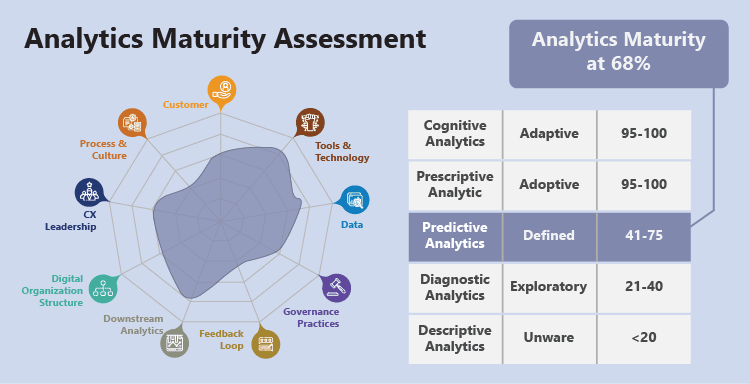Analytics Maturity Model: The Journey toward Analytics Excellence
Data analytics has become the point of focus for most organizations over recent years, because of the competitive edge that is afforded by data-backed decision-making. And having a robust analytics framework determines how efficiently data can be analyzed, and how effective the business decisions will be.
But organizations often face challenges with analytics practices, from infrastructure to resources, to efficiently handle the analytics requirements of the organization. As a result, 61% of organizations are not able to leverage their enterprise data as an asset to their business. Hence, it becomes crucial to evaluate a company’s analytics efforts and investments in order to recalibrate the strategy and implementation.
This is where Analytics Maturity Models come in.
What is an Analytics Maturity Model?
Just as the word “maturity” suggests “evolved” or “developed”, a maturity model indicates the journey to evolution. To put it simply, the analytics maturity model serves as a yardstick to gauge a company’s analytics capabilities and which stage they are at, in reference to the target stage.
Traditionally, analytics prowess was measured using self-assessment, and qualitative or quantitative reports. These methods lacked depth in understanding the analytics capabilities of an organization as they would be based on anecdotal evidence and checklists.
These studies were able to assess if an organization is leveraging specific analytics tools and technologies. But they failed to understand to what extent analytics was influencing business decisions and organizational activities. Additionally, it was also a challenge to gauge the difference in analytics maturity between different business functions. As an ideal alternative to these methods, businesses adopted studies that leverage analytics maturity models.
Models are basically schematic representations of complex growth cycles, which provide development guidelines to go from current to target state, with specific and measurable indicators and characteristics.
The analytics maturity model refers to the route taken during a company’s evolution, with regards to its ability to successfully integrate data from both internal and external sources, manage the data, and conduct analysis to transform the data into actionable insights that can influence business decisions.
It is about a complete amalgamation of technology, personnel, processes, and strategies; needed for extracting business value from raw data and acting on the insights to deliver business value.
The following are a few maturity models frequently used by organizations:
- Analytic Processes Maturity Model (APMM)
- Analytics Maturity Quotient Framework
- Blast Analytics Maturity Assessment Framework
- Data Analytics Maturity Model for Associations (DAMM)
- DELTA Plus Model
- Gartner’s Maturity Model for Data and Analytics
- Logi Analytics Maturity Model
- Online Analytics Maturity Model (OAMM)
- SAS Analytic Maturity Scorecard
- TDWI Analytics Maturity Model
- Web Analytics Maturity Model (WAMM)
As a company evolves along the ‘analytics maturity curve’, it may be using one or some of the five analytics phases – Descriptive Analytics, Diagnostic Analytics, Predictive Analytics, Prescriptive Analytics, and Cognitive Analytics. When in praxis, these different types of analytics can not only co-exist as well as complement one another but are also an indication of analytics maturity.
Image: Analytics Maturity Curve
Phases of Analytics Maturity
These five categories of data analytics, lie along the route to a company’s complete analytics maturity; with descriptive analytics being the initial stage, and culminating in cognitive analytics. Each stage transitions the company closer to maturity and increases its effectiveness in making strategic business decisions.
Descriptive Analytics considers current and historical data to reveal “what happened?”, by analyzing data from spreadsheets using basic BI reporting solutions. The tools leverage early data warehouse capabilities, relational database management systems (RDBMs), and online analytical processing (OLAP) techniques, to analyze the data.
Diagnostic Analytics delves deeper into the enterprise data and data mining capabilities, to identify “what happened and why?”. Even though this is still a fundamental process and leverages the same technology as descriptive analytics, it identifies the causalities behind the data, offering deeper insights.
Predictive Analytics as the name suggests attempts to uncover “what will happen, why, and when?”. Analyzing current and historical data to identify trends and patterns, attempts to predict future trends that can help companies make informed decisions. Machine Learning (ML) algorithms are used to develop advanced analytics models, and technology such as in-memory computing, Apache Hadoop, and Trusted Analytics Platform (TAP) deliver insights that impact the company’s future.
Prescriptive Analytics on the other hand offers insights on “what should happen?” and “what should the company do?”, for future predictions concerning the company, its competitors, products/services, and even the market ecosystem in which they operate. ML and deep learning capabilities analyze big data through algorithms and statistical learning frameworks and prescribe actions for decision-makers.
Cognitive Analytics is the future of data analytics, where AI works along with humans, to support the decision-making process. It is a completely automated process, where ML models with self-learning features, drill down into enterprise data, to deliver actionable intelligence. This eliminates the need for analytics expertise and offers curated insights to even non-trained personnel who access the data.
Most companies at present have experience with using descriptive and diagnostic analytics. These form the foundation for advanced analytics capabilities and help organizations progress towards complete analytics maturity, where automation takes care of the labor, and forecasts help to take better decisions and actions.
| Descriptive Analytics | Diagnostic Analytics | Predictive Analytics | Prescriptive Analytic | Cognitive Analytics |
|---|---|---|---|---|
| Users of the Analytics | ||||
| Front line workers, Sales force | Sales Manager, Marketing Manager | Chief of Production, Business Development Manager | CEO, CIO, CXO | Decision-Makers at Every Level |
| Business Decisions | ||||
| Operational, Day-to-day | Marketing and Sales Strategies | Budgeting, production optimization, R & D | Strategic, Developmental, Pioneering | Real-time Operations Optimization, Quarterly Targets, Annual Budgets |
| Who Does the Analysis | ||||
| Data/Business Analyst, Part-time Data Engineer | Data/Business Analyst, Data Scientist, Data Engineer | Data/Business Analyst, Data Scientist, Big Data Engineer, Big Data Architect, ML Engineer | Data Scientist, Big Data Engineer, Big Data Architect, Chief Data Officer, Chief Analytics Officer | Automated Systems / Machines / Data System Administrators |
| Which Tools are Used | ||||
| Files, RDBMS, ODS, Early Data Warehouse, OLAP | Files, RDBMS, ODS, Early Data Warehouse, OLAP | No/NewSQL, Mature In‐Memory, DB and Processing, Early Data Lake | Mature Data Lake, Simulation-based Analysis | AI, ML, NLP, Computerized Human Thought Simulation |
| Insights Gained | ||||
| What Happened? | Why did it Happen? | What will Happen? | What Needs to be Done? | Perishable Insight for Real-time Action |
| Use Cases | ||||
| Economic Efficiency, Marketing Activities, Customer Profiling | Identifying Trends, Detecting Quantitative Relationships | Predicting Future Trends and Market Conditions | Support Business Decisions and Automate Action | Detect Trends, Develop Analytics Models, Support Business Decisions |
| Evolve to the Next Level | ||||
| Develop a Data Culture, Hire Data Science and Data Engineering Professionals, Develop Infrastructure, Introduce Diagnostic Analytics | Data Democratization, Introduce ML, Automate Predictive Analytics | Organization-wide Data Governance, Introduce DataOps and MLOps, Automate and Optimize Decision-making | Maintain and Optimize Analytics Infrastructure and Capabilities | Maintain Agile Analytics Culture and Optimize the Business as a whole |
Challenges with Analytics Maturity Assessment
One of the primary challenges is the misconception that analytics maturity is a linear path. In reality, it is a ‘building blocks’ model. Where instead of moving from one type to another, you are adding the next block to your existing analytics ecosystem. Descriptive analytics is the foundation for diagnostics. Diagnostic for predictive and so on. If you don’t know “what happened”, how will you determine “what will happen” and “what to do about it”?
It is worth noting that the objective of analytics maturity models is to decide the baseline of maturity and build a clear analytics roadmap to move further ahead. And this journey is never one-dimensional. You will always have quick wins and low-hanging fruits to capture in the form of different analytical priorities across multiple business areas, while you are constantly building the baseline.
Secondly, businesses should understand that one analytics maturity level does not apply across all business functions. For instance, a product development team may get enough business intelligence from descriptive analytics reports, but the marketing team may require deeper insights mined by AI and ML algorithms, to derive better ROI from campaigns.
So how do you figure out where you stand on the analytics maturity curve, and which analytics maturity model will help you overcome the challenges?
How to Assess Which Model is Right for You?
As discussed before, there are varied analytics maturity models available to choose from. Analytics outsourcing organizations offer personalized models developed to integrate with a company’s specific goals and strategy. Attractive maturity models have almost become sales tools for attracting potential clients, and not all models are worth investing in.
Analytics vendors are developing analytics models that work best with their proprietary products, creating a need for depending on their product and investing further with the vendor. Companies looking to select an analytics maturity model should ensure that the model is balanced, compatible with other BI tools, and not restricted to a specific platform.
Organizations also have the impression that the maturity model will offer a detailed process for enhancing their analytics capabilities. But that is not the case. An efficient analytics maturity model identifies where a company stands, and where they need to be to achieve maturity.
Fundamentally they are measurement tools, and the maturity curve helps to assess the company’s analytics processes, techniques, tools, and other resources.

Image: Example of Analytics Maturity Assessment by Course5 Intelligence
And finally, following industry trends and updating itself, should be fundamental to any quality analytics maturity model. With the data analytics market constantly evolving, new technologies are being introduced, and new job opportunities are presenting themselves. Backdated information results in a continuation of legacy system implementation, and development of an unproductive analytics roadmap.
There may be best practices suggested for optimal maturity, but the company has to do the groundwork themselves.
How to Improve your Organization’s Analytics Maturity
As mentioned earlier, an analytics maturity model does not offer steps to follow along the journey to analytics maturity. It helps a company understand where they stand and where they need to be. The following are some factors that you can consider while enhancing your company’s analytics maturity, and better utilizing your enterprise data to make impactful business decisions.
Select the appropriate model and evaluate your current state:
Select the right model for your enterprise, or partner with an analytics outsourcing vendor to develop a model customized for your specific requirements.
Start off by identifying what data your organization is leveraging, locating its source, which personnel handles the data, and what tools they use to analyze it. This will let you form a basic understanding of where your company stands before you invest in new analytics solutions.
Explore data sources and insights they offer:
Find out all possible data sources, both internal and external, that can provide you with crucial data. Track key performance indicators (KPIs) to better monitor your company’s performance, gather valuable customer feedback, and leverage website analytics solutions. Also account for and measure business decisions and their impact.
Do not simply focus on data that offers insights on “how many”, but data that provides actionable intelligence regarding “why and how”. These insights help to better understand your own business processes, their impact, and the subsequent customer behavior. And a better understanding of these factors makes for smarter predictions and impactful decisions.
Create democratized access to data:
Dismantle data silos, provide every business function access to enterprise data, and train your personnel to manage these tools. Consider leveraging augmented analytics tools to introduce data democratization into your business process. Let automation deliver actionable insights, and with informed decision-making at every stage, the entire business will start to benefit.
Consider personas of business users:
Every business function needs access to data specific to its requirements, and there are particular individuals or personas managing these business functions. Hence, the roles and responsibilities of these personas are fundamental to a company’s journey towards analytics maturity. Your analytics investments should be strategic and should empower individual decision-makers.
Invest in technology and train the stakeholders:
Investing in cutting-edge analytics tools will help propel your analytics maturity, with greater access to data and actionable insights made easily available. But since all stakeholders are not trained analysts, you need to offer them some training on how to operate the analytics tool, ask questions about the data, and interpret the insights visualized by the tool. The tools have user-friendly interfaces and simplify business intelligence through visual stories. When data can be easily understood and put into context by the analytics platform, every stakeholder with industry experience will be able to make impactful business decisions at every stage of the company.
Course5 as a Partner Across Data & Analytics Maturity
Irrespective of where you stand with regard to your analytics maturity and the business challenges you may be facing, the road to analytics will not always be linear. There will be some back-and-forth as you try to strengthen your analytics capabilities and achieve optimal maturity. A right analytics partner can help you establish a robust data-driven culture.
Analytics India Magazine suggests that businesses should also evaluate the maturity of the analytics vendors before they outsource services. As a way to set an industry benchmark for analytics companies, AIM has established the Penetration and Maturity (PeMa) Quadrant. Assessing factors such as Customer Confidence, Work Delivery, Median Employee Experience, Support Functions, and Annual Data Science R&D Budget, AIM has recognized Course5 as one of the leading analytics providers.
Course5 enables organizations to set up their data engineering pipelines, employ AI and ML-powered tools for automated analytics and insights generation, transform BI into comprehensive visuals, and use cutting-edge data science to solve business problems and deliver business value.
We are here to help your organization continue to develop its analytics maturity and once data democratization becomes native to your organization, decision-makers will be empowered with access to vital business intelligence, and the competitive advantage gained will elevate you from your competition.
Don’t miss our next article!
Sign up to get the latest perspectives on analytics, insights, and AI.






